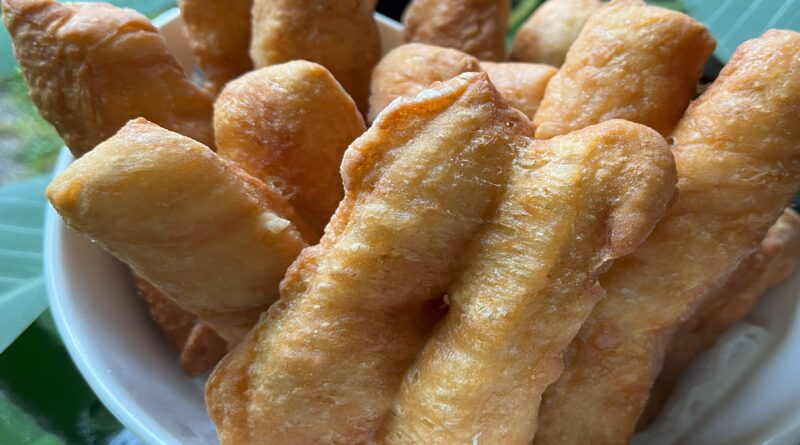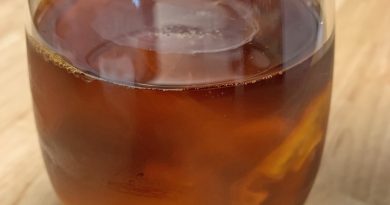Patongko
Patongko is the Lao and Thai version of the Chinese fried doughnut, youtiao. Many of the Southeast Asian countries have adapted a version the doughnut and it is known by many names. One can easily see why it is so popular. Sometimes served with warm soy milk or cut into pieces and served on porridge or khao piek. For some of us, it has a special place in our hearts as a comfort food.
This recipe took me years to develop and test. I lost count of which version of the recipe I’m on. I’ve even tried other people’s popular recipes and they end up as duds. For the longest time, I thought it was an ingredient substitution issue. I’ve tested everything from alum to yeast. From all-purpose flour to rice flour. At the end of the day, the method proves to be more important than the ingredients. To make the doughnuts light and hallow-like, the best trick that I found is to turn off what I have learned about making yeast dough. Once I did that, it was so much easier than I thought, which is probably the way it should be because the best comfort foods are simple. The best part is that there’s no kneading involved!

Notes:
• Dough – it is a wet dough. Wetter than you’d expect dough to be, but a good doughnut dough is wetter than you’d expect. Try not to add too much flour because you think that it should be a nice round dough ball that has pulled cleanly away from the sides of the bowl. We’ll make up for the wetness of the dough by generously flouring our work surface.
• (No) Knead – you don’t need to knead it. Make sure all the ingredients and combined and mixed well before adding the water. Then mix well again once you’ve added the water. After it has risen, don’t punch the air out and don’t knead it as you typically would when making yeast dough. Your goal is to try to keep the air in the dough as much as possible.
• Greasing the bowl – make sure to grease the bowl well. This will help when you turn the dough out of the bowl. If it is not greased well, the dough will stick to the bowl, and it will deflate the dough. I really like using cooking spray for this purpose.
• Making Pairs – Work with as many pairs as you can fit in your fryer at a time. Brush the top and gently press the dough pieces right before you are ready to fry. There were many attempts when I brushed the tops and placed the other pieces of dough on top, and then let them sit there for a while before they are fried. The two pieces end up melding into one and the bottom is partially deflated by the weight of the top piece. Make it a quick series of actions. Brush the top, place a piece on top, press gently, and toss into the fryer.
• Frying – when frying, make sure to constantly turn the patongko during the first 30 seconds or so, this helps to heat all sides equally, which will help the dough rise on all sides equally. It will also cook more evenly.
• Powdered sugar – I was asked to put this note in by my little. Sprinkle a little powdered sugar on top of these and they make a great treat.
Patongko
Yields: 1 dozen
Time: 2 hours (including inactive time)
3 ¼ cups (390g) all-purpose flour + plus more for dusting
2 tablespoons (25g) sugar
1 envelope (7g) instant dry yeast
½ teaspoon salt
1 teaspoon baking powder
1 ¼ cup (295 ml) lukewarm water + more for brushing
Oil – for frying and for greasing the bowl (cooking spray can be used for the bowl)
• In a large bowl, combine 3 ¼ cups of flour, sugar, salt, baking powder, and yeast. Stir or mix the ingredients before adding the 1 ¼ cup water.
• Mix well. It will be a wet dough. Don’t add additional flour.
• Grease the bowl with a couple of teaspoons of oil or use cooking spray. Cover with a clean kitchen towel.
• Place in a warm spot and the dough rise for about an hour to an hour and a half.
• Generously dust the work surface with flour. Turn the dough onto the floured surface. Try not to deflate the air bubbles in the dough.
• Cut the dough in half and shape the halves into long rectangular logs.
• Cut each log into 12 equal pieces. (You should have 24 pieces total, but this can vary depending on the size that you cut)
• In a fryer or heavy bottom pot, heat the oil to 350 degrees.
• Right before frying, brush the top of one piece of dough with a little bit of water. Place another piece on top. Gently press them together and place the pair into the fryer.
• Fry for 3-4 minutes. Turn the dough constantly for the first 30 seconds or so for even puffing.
• Once the doughnut is golden brown on both sides, remove from the oil and place on a paper towel lined plate.
• Serve warm or cooled. Enjoy!
Discover more from Crafts to Crumbs
Subscribe to get the latest posts sent to your email.



